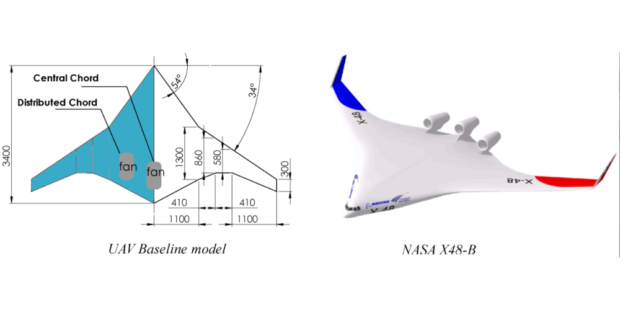Researchers at the Escuela Politecnica Nacional in Ecuador have just published a paper which examines a formulation for the sizing of ducted fans for BLI configurations with a distributed propulsion system, based on the NASA X-48B.
Abstract
The implementation of distributed propulsion and boundary layer ingestion for unmanned aerial vehicles represents various challenges for the design of embedded ducts in blended wing body configurations. This work explores the conceptual design and evaluation of DP configurations with BLI. The aerodynamic integration of each configuration is evaluated following a proposed framework, including simulation analysis. Power saving coefficient and propulsive efficiency were compared against a baseline podded case. The results show the optimal propulsion configuration for the BWB UAV obtaining 3.95% of power benefit and propulsive efficiency (𝜂𝑝>80%). Indeed, the aerodynamic integration effects for the proposed design maintain the BWB’s aerodynamic efficiency, which will contribute to longer endurance and better performance.
Introduction
In the last decade, the aviation sector has faced rapid growth due to the expansion of civil and military applications, which impose a significant air and acoustic pollution footprint. In this context, novel innovations such as blended wing body (BWB), distributed propulsion (DP), and boundary layer ingestion (BLI) have been developed to increase aircraft performance and reduce fuel consumption.
In particular, BLI technology captures a portion of the boundary layer produced along the fuselage and re-energizes it using the propulsors to dismiss the drag due to friction [4] to increase propulsive efficiency. In addition, implementing BLI coupled with embedded ducts reduces airframe weight and noise pollution, since embedded propulsors allow for a reduction of the wetted area and the structural weight considering the pylons’ dismissal.
On the other hand, DP replaces the single propulsor with independent small propulsors, which allows for achieving high bypass ratios. However, in civil aviation, the implementation of BLI with DP presents challenges related to integration and design of the airframe and embedded engines, owing to the strong regulations and large infrastructure needed for the implementation of these concepts. This makes them more complicated to adapt for current aircraft civil aviation concepts. In the case of unmanned aerial vehicles (UAV), broad design space, low costs, and lighter regulations make the aforementioned technologies suitable.
Some DP technology difficulties focus on the identification of the fuel burn reduction potential , whereas the critical difficulty in the BLI field is the coupling effect of BLI on the aircraft fuselage. Diamantidou, Hosain, and Kyprianidis compile the advances in boundary layer ingestion technology to show their advantages in fuel burn and noise reduction, reducing the environmental impact.
This work shows the state of the art in the last decade, where notable designs include the hybrid wing body (HWB) and blended wing body (BWB) concepts. These aircraft combine the airframe with propulsion interaction. In the most notable examples, the N2B and N3-X concepts have better performance for low fan pressure ratios.
The use of rear-mounted engines, where propulsors are located aft of the fuselage, leads to improved system performance. The D8 concept is an example of this category, where the benefit is affected by ingested dissipation, propulsor jet velocity, and BLI installation. The propulsive fuselage concept (PFC) model absorbs the central part of the airframe boundary layer by a propulsor located at the aft part of the fuselage, since its viscous drag is one of the largest portions compared to the aircraft’s viscous drag, as mentioned by the authors of Recent Advances in Boundary Layer Ingestion Technology of Evolving Powertrain Systems . According to the article, the STARC-ABL concept is one of the most well-known PFC models, which shows the importance of coupled simulations and shows where lower FPR (fan pressure ratio) is favourable.
Budziszewski and Friedrichs analyzed the power reduction of a BLI system vs. a pylon configuration through a parallel compressor model approach, where a propeller was located at the rear upper region of the fuselage of the aircraft where low velocity and non-uniform flow are present. Results showed a significant reduction in power consumption of the fans, leading to a 5.4% power saving coefficient. Some methodologies, such as the power balance method and exergy-based assessment, have been developed for solving this effect and have proven their application to BLI.
Those frameworks are intended to start with a defined freestream velocity, and then the aircraft weight is found. In the present article, the authors propose to do it in reverse; that is, based on the aircraft weight, the BLI benefit over conventional podded propulsor configurations is determined. The present design focuses on the aerodynamic advantages of BLI over conventional podded engine configurations for the representative BWB NASA X-48B in DP arrangements.
The complete paper can be downloaded here.
Source: MDPI

